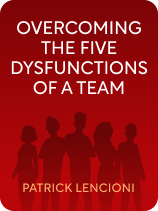

This article is an excerpt from the Shortform book guide to "Overcoming the Five Dysfunctions of a Team" by Patrick Lencioni. Shortform has the world's best summaries and analyses of books you should be reading.
Like this article? Sign up for a free trial here.
How well does your team function? Is it hitting on all cylinders, or does it need a tuneup (or even an overhaul)?
“Teamwork” is one of the most common buzzwords in the modern business world. But, what does it actually mean, and how do you foster it? In Overcoming the Five Dysfunctions of a Team, Patrick Lencioni answers those questions and teaches you how to turn a group of individuals into a true team.
Continue reading for an overview of this book that every manager should read.
Overview of Overcoming the Five Dysfunctions of a Team
Overcoming the Five Dysfunctions of a Team is a follow-up to Lencioni’s 2002 business fable The Five Dysfunctions of a Team. While the earlier work focused on identifying the problems that stop people from working together effectively, Overcoming teaches you how to solve those problems and explains why, according to Lencioni, all teamwork must begin with trust.
Lencioni is an author, speaker, and renowned business consultant specializing in leadership and business management. He’s also co-founder and president of The Table Group, which specializes in executive team development and organizational well-being. Lencioni’s books about business and leadership have sold millions of copies worldwide.
We’ll start by briefly explaining Lencioni’s definition of team and why not all groups can or should be teams. We’ll then discuss each of the titular five dysfunctions—distrust, lack of healthy disagreements, disunity, fear of accountability, and self-interest—and explore how you can surmount them to build a cohesive, effective team. Although this book is targeted at managers and executives (in other words, people responsible for building and running teams), its insights about teamwork and trust can benefit anyone who works closely with other people.
(Shortform note: Lencioni’s book is arguably organized logically: He begins with an overview of the five dysfunctions, then further explores each in the order in which you should address them (for instance, overcoming the dysfunction of distrust first, as trust is necessary for addressing the other four dysfunctions). We’ve woven his descriptions of the five dysfunctions into their respective sections for clarity and ease of reading.)
Introduction: Creating a Team
Lencioni starts by giving his definition of a team: a group of up to 12 people who come together and work collectively to meet shared objectives and put the group’s needs above their own. He adds that smaller teams are often the most effective, and you should rarely—if ever—try to make a team larger than a dozen people. Groups larger than that have too many opportunities for interpersonal conflicts, making it exponentially more difficult to arrive at decisions they all agree with.
Lencioni notes that it’s very difficult to get people to go against their selfish instincts and work toward collective goals. He suggests tackling this problem by creating a timeline of specific team-building activities and objectives. This team-building process should be designed so team members will get to know each other, learn to trust one another, and (as much as possible) break their habit of focusing on themselves.
Lencioni warns that people are likely to resist these team-building activities at first; team members will complain that they’re annoying and a waste of time. Therefore, explain that team-building exercises are an investment. Any time and resources you spend now will pay off many times over in the long run because of your improved teamwork.
Now that we’ve covered the basics of team building, let’s explore the five dysfunctions related to building a strong team.
Dysfunction #1: Distrust
Lencioni says that any great team is grounded in trust. However, in this case, trust doesn’t just mean trusting your teammates to do their work. It means feeling safe around each other: Teammates who trust each other aren’t afraid to share unusual ideas or admit to their mistakes and worries. Trust means knowing you can share anything (whether business-related or personal) with your teammates—you trust that they won’t use that information to make fun of you, steal your ideas, or harm your reputation.
Lencioni argues that distrust is the first and most important dysfunction to surmount because if you and your teammates don’t trust each other, then you can’t operate as a team at all. Without trust, your “team” is actually a group of individuals: people who are more concerned about protecting their interests than tackling the problems they’re supposed to be working together to solve.
For example, suppose an insurance agent accidentally sent an email containing personal information to the wrong client. In an environment of trust, that person would immediately admit the mistake to their teammates, and then the team could work together to minimize the damage; perhaps by having the company pay for identity theft protection services. On the other hand, in a distrusting environment, the insurance agent would just hide their mistake and hope nothing bad happened because of it—protecting their reputation would be more important than addressing the problem.
How to Build Trust in a Team
Lencioni says that, for teammates to trust each other, they first have to get to know each other. He recommends that you start by having people share relatively safe information about themselves—for example, their favorite book, a personal goal (work-related or otherwise), or a fun childhood memory. This will get them used to talking about themselves and will start forming interpersonal bonds between teammates.
Lencioni says you can also strengthen people’s understanding of one another—and therefore their trust in each other—by asking everyone to use a personality profiling tool. Lencioni notes that this will give team members an external, impersonal frame of reference for understanding each other’s behavior. For example, if a test shows that someone has an impulsive personality, their teammates will know not to take it personally if that person interrupts or talks over them.
Lencioni warns that while trust is necessary for any team, it can be very difficult to cultivate. This is because trust requires vulnerability: You have to be willing to expose your fears and your weaknesses, which people usually avoid doing at any cost.
To start overcoming that self-preservation instinct, the team leader should be the first to be vulnerable by sharing something uncomfortable or embarrassing—perhaps a mistake they made as a new employee or a time when they made a minor social faux pas. By doing so, they’ll signal to the rest of the team that it’s safe to share things they normally wouldn’t.
Dysfunction #2: Lack of Healthy Disagreements
Once your team trusts each other, they’ll be ready to start working through Lencioni’s second team dysfunction: a lack of healthy disagreements. In other words, now that your team members trust each other to act in good faith, you can teach them how to disagree with each other respectfully and productively.
Lencioni notes that ideally, disagreements and disputes get a lot of different ideas out in the open so your team can thoroughly discuss them and choose the best option. That’s why the ability to have healthy disagreements is crucial for any team.
We’ll explain how to encourage healthy, constructive debates. Doing so first requires you to understand team members’ different styles of disagreement—aggressive and argumentative versus calm and logical. It often also requires guidance from the team leader during discussions. Let’s look at each of these requirements in detail.
Understanding Styles of Disagreement
Lencioni says that just like you do with building trust, you should begin the process of fostering healthy debates by helping your team members understand each other. Specifically, have a conversation with the team about how each of them approaches disagreements.
For example, how comfortable are each of your team members with arguing? What tactics do they tend to use in arguments—passionate appeals to emotion, calm and logical arguments, or somewhere in between? What cultural and familial influences formed the foundations of their disagreement styles?
Once you have an overall idea of how your team handles conflict, Lencioni says to establish what he calls conflict norms. Work with your team to set rules and expectations for debates—that way, they can handle disagreements in a way that’s effective and comfortable for everyone.
Guiding Disagreements
Lencioni says that even after you’ve established that disagreements are expected and desired and have set your conflict ground rules, you’ll often have to encourage your team to start debates.
First, start team meetings by telling everyone what you’ll be discussing that day, why it’s important, and what the consequences will be if the team makes a bad decision. This will ensure that your teammates are engaged and energized right from the start.
You might also need to help keep the discussion going. For example, if there’s a team member who tends to be quieter than the others, specifically ask for that person’s input from time to time. Lencioni also says that you should look for potential conflicts and try to bring them out into the open during meetings. If you suspect someone has an objection or argument that they’re holding back, encourage them to speak up.
Finally, Lencioni says that, although it’s important to encourage discussion and disagreements, a team leader also needs to know when to bring a debate to an end. Your team will often be unable to reach a consensus; if the conversation seems to be going in circles or tempers are wearing thin, it’s time for the team leader to step in and make a final decision.
Dysfunction #3: Lack of Unity
The ability to disagree with each other respectfully and productively is crucial for a team, but it naturally leads to Lencioni’s third dysfunction: a lack of unity. Some team members may resist going along with a decision even after it’s been made. For example, they might genuinely think the team made a bad decision, or they might simply feel slighted because their ideas weren’t chosen.
We’ll go over Lencioni’s method for having your team present a united front: 1) ensuring clarity among the team members and 2) requiring them to communicate decisions to their subordinates.
Ensuring Clarity
Lencioni’s first tip for achieving team unity is making sure all team members understand exactly what decision they reached during the meeting. To support a course of action, they first need to know what that course of action will be.
Therefore, right before ending a meeting, clearly and specifically write down and share what the team has agreed to. This is also an opportunity for team members to share anything they’re confused about and to eliminate any ambiguity.
For example, say your team decided to have the company adopt a new type of software. You could write down that the team decided to phase out whatever software your company is currently using and require all employees to start using this new program. If one of your team members assumed the new software would just be an option for employees rather than a requirement, these last few minutes of the meeting are that person’s chance to clear up their confusion.
Requiring Communication
Lencioni’s second tip for achieving unity is holding each team member responsible for explaining the decision to everyone who reports to them. By doing so, you’ll make sure they’re personally invested in team unity: They know there will be consequences if they don’t explain the decision willingly and accurately.
It’s not enough for your team members to send a simple email or voicemail communicating the decision to their staff—they must do so either in person or over a phone call so their employees will have the chance to ask questions and voice concerns. This requirement also helps ensure that team members fully understand the decision before they communicate it; since they’ll have to explain the decision and answer questions about it, they’ll want to make sure they understand it themselves.
Dysfunctions #4 and #5: Fear of Accountability and Self-Interest
Discussing unity naturally leads to the last two dysfunctions: fear of accountability and self-interest. These both hinder team unity by keeping people’s attention focused on themselves. We’ll explain these two dysfunctions and discuss ways to keep team members accountable to and intent on meeting the team’s shared goals.
Dysfunction #4: Fear of Accountability
Lencioni argues that accountability involves team members—including the team leader—holding each other responsible for their behavior and their results.
Holding people accountable for their results is easy. If there are clear expectations regarding, say, sales numbers or company profits, it’s easy to tell when someone isn’t meeting them. In that case, there needs to be a conversation about why they’re falling short and how to address the problem.
Lencioni says it’s much more uncomfortable to hold people accountable for their day-to-day behavior. But, it’s just as important because behavior leads directly to results; by correcting behaviors, you can stop poor results from happening in the first place. For example, if one of your team members seems disengaged or hostile during team meetings, that bad behavior might also come through when they’re talking to customers, thereby harming sales.
How to Overcome the Fear of Accountability
According to Lencioni, to help your team overcome their fear of holding each other accountable, you must first help them realize that it’s really the fear of hurting each other. Accountability is personal—as a result, calling out your teammates’ shortcomings often feels judgmental and unkind. This holds true for the team leader and team members alike.
Once you understand where this dysfunction comes from, you can start taking steps to overcome it. Specifically, change your team’s mindset: Explain that failing to hold each other accountable is much more harmful than the brief discomfort of a difficult conversation. Holding back criticism doesn’t just harm the company—it also robs team members of the chance to improve.
Lencioni adds that the most effective type of accountability is between teammates. This is because criticism feels more personal and more meaningful when it comes from a peer instead of from “the boss” (the team leader), who’s in a position where giving feedback and criticism is just part of their job. Therefore, overcoming the fear of accountability—empowering team members to give each other feedback—is more effective than any feedback the leader could give personally.
Dysfunction #5: Self-Interest
Fear of accountability hinders teamwork because people are too concerned about hurting their teammates; self-interest hinders teamwork when people go too far in the other direction and aren’t concerned enough about their teammates.
Lencioni says that people are naturally self-centered, and as a result, they lose sight of the big picture: company outcomes. We’ll briefly examine a few ways that self-interested behavior can harm the team and the company. We’ll then discuss advice on how to keep the team focused on company outcomes.
The Problems With Self-Interested Behavior
Self-interested behavior can have several negative impacts on companies and teams. First, Lencioni notes that people might resist ideas that hinder their personal goals, even if those ideas are good for the company as a whole. For example, if the team decides to hire an outside expert to fill an advisory role that a less experienced team member was hoping to get, the team member in question would likely oppose that idea.
Team members may also sometimes suffer from tunnel vision—focusing too heavily on their own work or their own department—and may not take into account how the company as a whole is performing. For instance, if the manager of a manufacturing team is having the team cut corners to produce vast amounts of a product, that manager’s personal metrics might look exceptional. However, their team’s shoddy work will harm the company in the long run when customers realize that their products are of poor quality.
Finally, self-interest may give rise to egotism, where one team member thinks they’re more important or more capable than the team as a whole. Lencioni notes that this is especially common with top performers, whose exceptional work often shields them from the consequences of bad behavior and rule-breaking. However, he says that no one person—no matter how good they are at their job—is more important than the team. Therefore, anyone who can’t let go of ego and commit to the group should be removed from it. You’ll find that the team’s improved overall performance more than makes up for the loss of one top performer, leading to better outcomes for the company as a whole.
How to Keep the Team Focused on Outcomes
To shift people’s focus off themselves and onto overall outcomes, Lencioni suggests choosing and visibly tracking one or two company metrics related to the team’s overall goal. You’ll be constantly reminding your team of their big-picture goals and letting them see their progress toward those goals. For example, you might maintain a shared online document or write the chosen metrics on a whiteboard before each team meeting.
Note that the metrics you choose must be objective and measurable, such as sales numbers or customer reviews. In other words, set a simple and concrete goal for your team to reach, and track appropriate metrics to keep each team member focused on that goal.
Exercise: Consider Which Dysfunctions You Currently Face
Now that you’ve read about Lencioni’s five team dysfunctions and how to work through them, think about which dysfunctions are currently holding your team back or preventing you from fully committing yourself to a team or company.
- If you’re currently part of a team, which of the five dysfunctions (distrust, lack of healthy disagreements, lack of unity, fear of accountability, or self-interest) do you think the team struggles with most, and why? If you’re not on a team at the moment, which dysfunction do you anticipate you’d personally struggle with on a team, and why? For example, maybe you’re uncomfortable with disagreements (lack of healthy disagreements), or you can’t imagine yourself publicly supporting a decision you think is wrong (lack of unity).
- Whether you’re currently on a team or not, what’s one thing you can do today to start overcoming the dysfunction you identified in the previous question? For example, if you have trouble building trust with others, you might start by sharing an amusing anecdote about yourself with your coworkers at lunch; by sharing a personal story, you’ll leave yourself slightly vulnerable and thereby start establishing trust with your colleagues.
- Think about a personal goal. How could helping a team or company achieve its goals help you to achieve that goal? This answer might be as simple as getting a steady paycheck to help fund your goal, or as complex as finding a team or company with a mission you believe in and then doing your part to help them realize that mission.

———End of Preview———
Like what you just read? Read the rest of the world's best book summary and analysis of Patrick Lencioni's "Overcoming the Five Dysfunctions of a Team" at Shortform.
Here's what you'll find in our full Overcoming the Five Dysfunctions of a Team summary:
- What "teamwork" actually means, and how to foster it
- Why trust is the most important element in an effective team
- The five impairments to teamwork and how to overcome them






